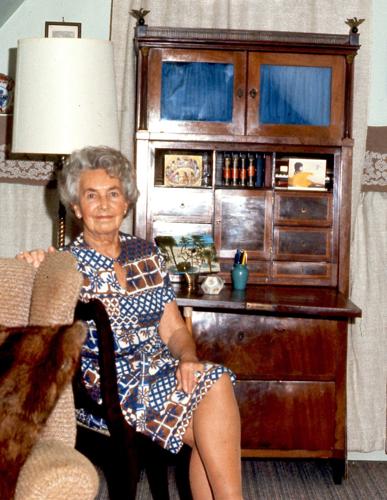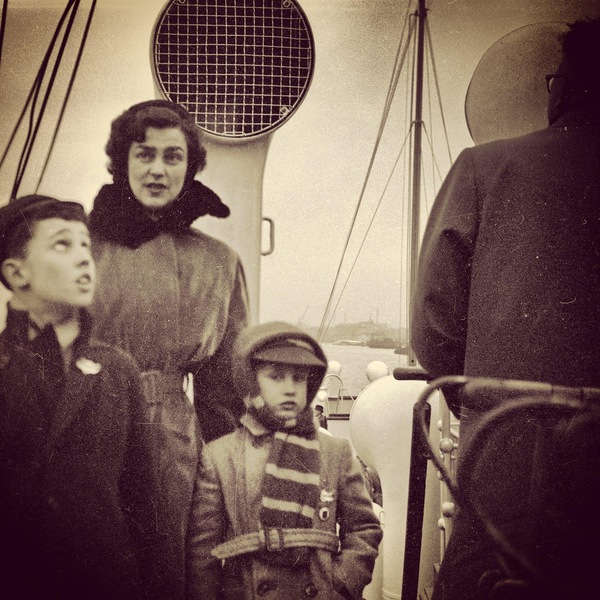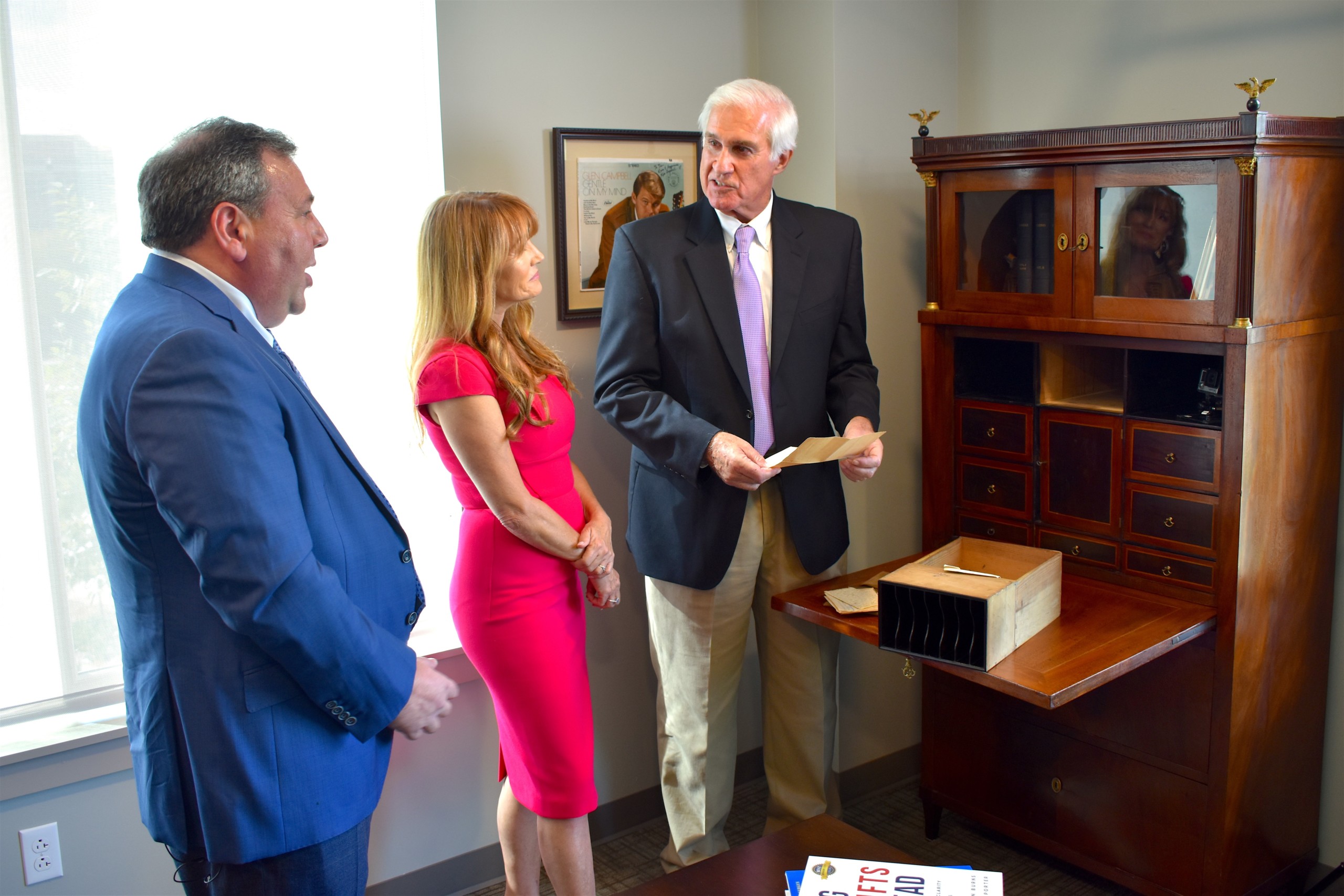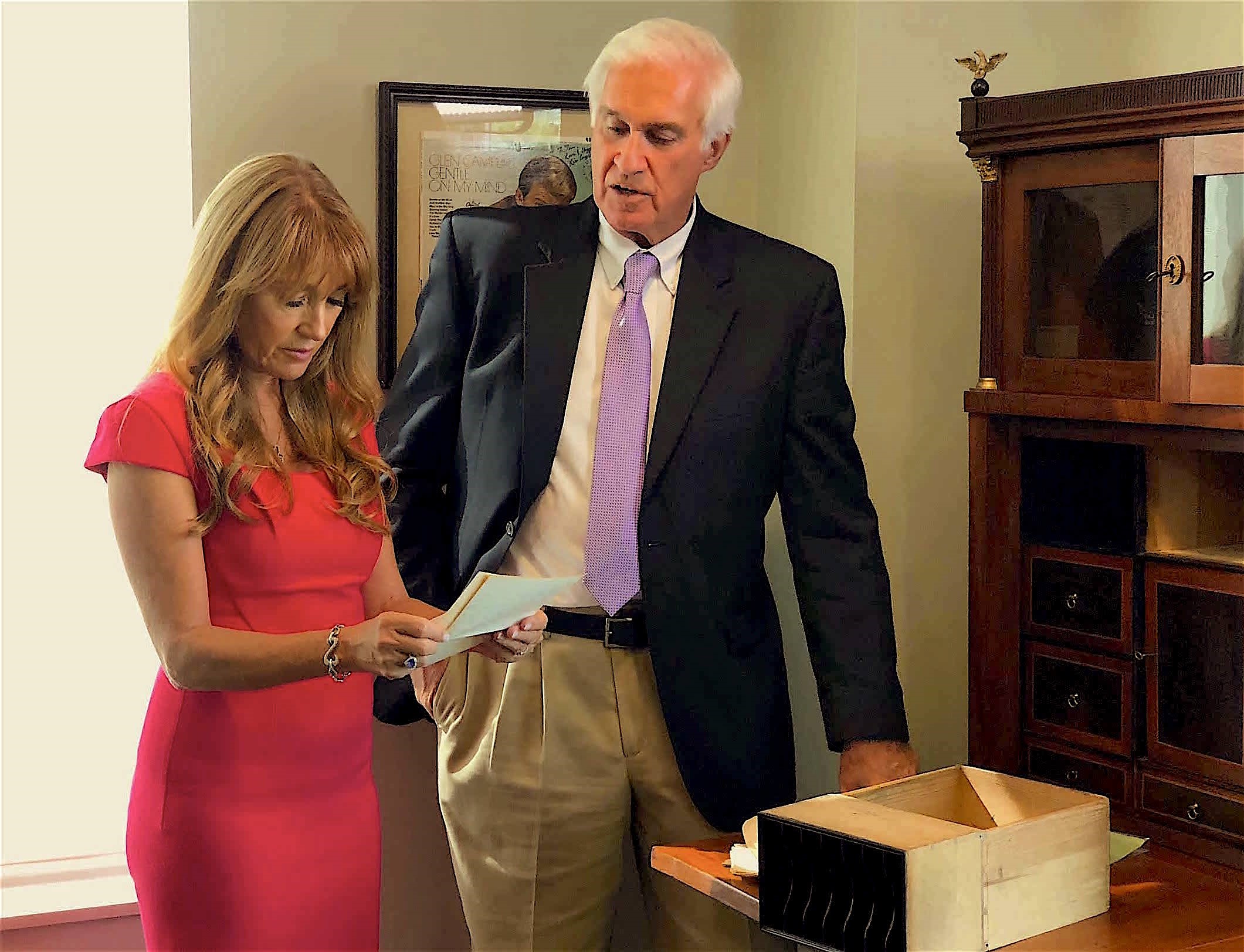When finding happiness in retirement, our clients take many different paths. From time to time, we like to shine a light on the road a particular person has traveled. We’ve covered a lot of territory, but today’s spotlight illuminates more hallowed ground.
Rather than a passion for golf or a yearning to hike across multiple state lines, Frank Pringham’s story is a search for truth.
Now a Sandy Springs resident, the first leg of Frank’s quest began in Detroit, where his grandmother, Helen Sebba, lived in a retirement community until 1989. After she passed away, a community employee named Tim Mallad purchased her unwanted family desk. Tim didn’t know at the time that there was a hidden compartment containing a passport, old photos, and letters that would eventually lead him to Frank and change both of their lives forever.

Helen Sebba at her home in Detroit by the desk where she hid the letters in a small compartment in the center behind the small books.
The letters found in the secret compartment were written in German, which Tim didn’t speak. Repeated attempts to translate them resulted in vague, lachrymose summaries from the German-speaking acquaintances he asked. Tim knew it wasn’t something good and knew they were talking about the death of a 13-year-old but didn’t know the details.
Incredibly, it was a chance encounter with actress Jane Seymour (yes, Dr. Quinn Medicine Woman and the Bond Girl in Live and Let Die) on an airplane that motivated him to hire an official translator. Tim recalls sitting on a plane with her, “I told her I had these mysterious letters. She looked me in the eye and said, ‘You must have those letters translated. They were hidden for a reason.’ She was emphatic about it.”
Tim obliged and did as Jane requested. It turned out the letters were written to Frank’s Grandmother, Helen Sebba, in 1946, just after the end of World War II. She along with her husband and daughter (Frank’s mother) had fled Germany just before the outbreak of the war. Her brother, a doctor named Willy Weiss, had remained with his wife Dora, and their thirteen-year-old daughter, Ulla. The Weiss family had taken in a refugee named Olga Holzapfel, who would eventually author the letters.
As one might imagine, the content of the letters is not for the faint of heart. Unspeakable acts occur in wartime, and the advancing Soviet army was brutally savage at that stage of the conflict. The result of their brutality and vulgarness was the tragic death of the entire Weiss family.
Despite the heartbreaking reality, Tim pressed on, determined to find the Weiss relatives to let them know that some part of their family had been preserved. Most of the letters were addressed to the Sebbas, but one mentioned the Pringsheims (Frank Pringham’s father’s family had anglicized their name after escaping to London). After some effort, Tim eventually located Frank. “Somehow he found me on Facebook,” Frank revealed in the Northside Neighbor. “He had recognized my mother’s face in that little black and white photo from one of the photos that was in the desk. So that’s when he set out to find me.”

Frank and his brother with their mom on board the SS Liberte, which was the boat they came over to America on in 1954 from England. It was Frank’s profile photo at the time Tim found him on Facebook.
Frank knew nothing about that side of his family, and the letters were a shock. “My grandmother certainly didn’t bring it up, though in her late years she reverted back to her German language,” he told the Northside Neighbor. “Every once in a while, I would hear her say, ‘mein bruder,’ which means ‘my brother.’ So at that point, for the first time, I realized she had a brother. But when Tim called me, that just opened up a whole new world for me.”

Tim Mallad, Jane Seymour and Frank Pringham meet to see the old desk and letters hidden by Frank’s grandmother.

Jane Seymour and Frank Pringham look through the hidden letters.
Eventually Frank and Tim decided to travel to the small town of Neustrelitz, just north of Berlin, to find out more about what happened to his ancestors. Then, with reporter/director Jason Whitely and his cameraman, they turned their discoveries and story into a documentary. “Let Us Die” premiered on October 18th at the Dallas International Film Festival. Frank attended and knew the audience would be as affected by it as he was. “That written word, that first-person account, is such an intimate thing,” he said in the Dallas Morning News.

Poster of the documentary film that was created from Frank and Tim’s discoveries.

Frank (middle left) and Tim (middle right) at the premiere of “Let Us Die” at the Dallas International Film Festival.
A story of such despair might not seem like a topic we normally discuss concerning happiness in retirement, and we certainly don’t take it lightly. We may never understand why other human beings inflicted such cruelty upon Frank’s family and countless others. But, the more we honor who they were, the more we allow their lives to shine toward the future.
Frank Pringham could have declined Tim Mallad’s requests. He could have stayed in his bubble and never pursued the answers to some gut-wrenching questions. But instead, his curiosity and reverence for family members who sacrificed their lives led him to a greater truth. He now calls Tim Mallad his “brother from another grandmother.”
The unhappiest retirees tend to stop living once they stop working. Put that in contrast with Frank traveling worldwide to pay respect to people who suffered the fate of history. Which one sounds more meaningful? Which direction do you want to go? We’re with Frank.
Please note, Frank and Tim have given us permission to share this story and photos.









